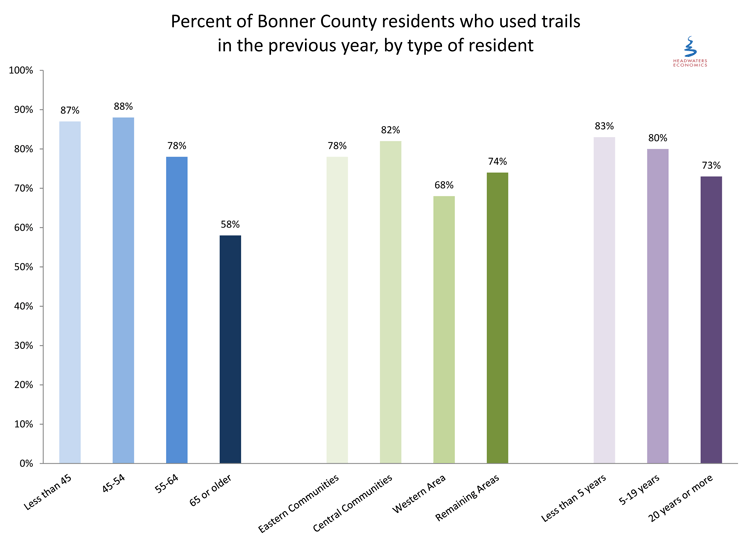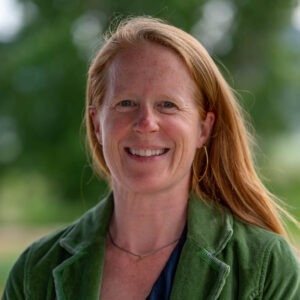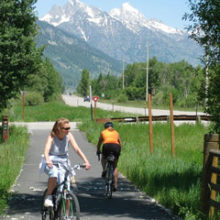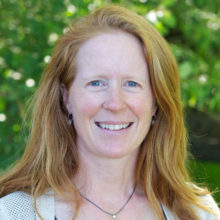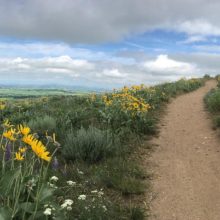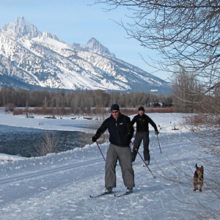- Three out of four residents used trails in the last year.
- Trail use is high in towns and rural areas, regardless of duration of residence in the county, income, or age.
- The survey results for Bonner County’s trail system provide reliable information to help the community prioritize improvements based on resident usage, satisfaction, reasons for living in the area, and suggestions for improvement.
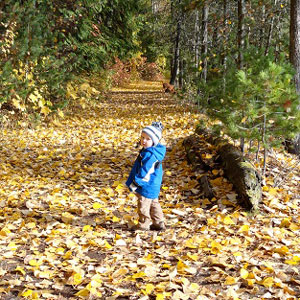 This research complements previous work evaluating socioeconomic trends in Bonner County. Together these studies provide insight into the factors that contribute to the community’s continued resilience and quality of life.
This research complements previous work evaluating socioeconomic trends in Bonner County. Together these studies provide insight into the factors that contribute to the community’s continued resilience and quality of life.
This report was prepared for the cities of Sandpoint and Ponderay, Bonner County, and the Greater Sandpoint Chamber of Commerce by Headwaters Economics and RRC Associates.
Methods for Bonner County Trails Survey
This survey was conducted in Fall, 2015 using three primary methods: 1) a mail-back survey, 2) an online, invitation-only web survey to further encourage response from those residents already within the defined invitation sample, and 3) an open-link online survey for members of the public who were not part of the invitation sample.
A total of 3,600 surveys were mailed to a random sample of Bonner County residents in August 2015. The final sample size for the statistically valid survey was 388, resulting in a margin of error of approximately +/- 5.0 percentage points for questions at 50% response. The open link survey received an additional 97 responses. The underlying data were weighted by age to ensure appropriate representation of Bonner County residents across different demographic cohorts in the sample.
Survey Results: Trails Valued Across Bonner County
Trails are essential to daily life for many Bonner County residents. Three out of four residents used trails in the last year. Residents use trails nearly every day in the summer and every other day in the winter. Use is high across towns and rural areas and regardless of length of residence in the county, income, or age. Trails are particularly popular among newcomers to the area, younger residents, and business owners.
Broad Support for Amenities
More than three-quarters of residents support the development of an expanded and better connected trail system in the county. Nearly nine in ten residents believe that protecting the rural character of areas outside cities is extremely important for Bonner County.
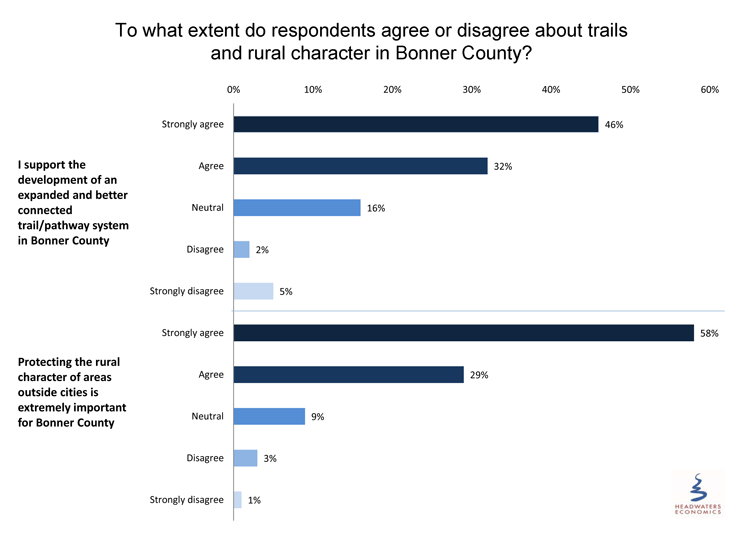 The survey responses highlight several ways in which trails can better serve Bonner County residents.
The survey responses highlight several ways in which trails can better serve Bonner County residents.
Trails Lack Their Own Identity
Although the county’s trails are popular, they do not have a strong identity separate from their role in providing access to other amenities. When residents identify what brought them to, or keeps them in, Bonner County they highlight access to the lakes and rivers, outdoor recreation, and public land. Relatively few respondents identified the trail system specifically, even though trails are essential for access to these resources.
Trails Closer to Homes
Residents want trails closer to where they live, suggesting demand for more trails in and around residential areas. More than half of respondents identified proximity to trails and safe places to take walks as important factors in their decision about where they live. One-fifth of respondents stated they would use the trails more if they lived closer to the trail system. Improving the trail network and increasing the number of bike lanes were also identified as factors that would increase use.
Easier Trails
There is a need for easier trails to encourage new trail users and increase use among existing trail users, including the elderly and those with disabilities. Eighteen percent of non-users cited a physical disability as the primary reason they did not use the trails more. When asked what factors could increase their trail use, 13 percent asked for easier trails.
Easier trails would also increase use among 17 percent of current trail users. This is particularly true among residents age 45 and older. More than one-fifth of trail users stated they are “not at all satisfied” with how well trails accommodate wheelchairs or mobility assistance devices. As current residents age and the area continues to be a retirement destination, trails that are easier to access and use will become increasingly important.
Better Information
There is a desire for more broadly shared information about trails. Among non-users, 21 percent did not use trails because they are unsure where they are. One-third of all respondents cited improved trailheads with parking, restrooms, and maps as the factor most likely to increase how much they use the trails. Eighty-four percent of trail users get their information about trails in the community from word of mouth. Informal communication may be effective between existing users, but it leaves out non-users and visitors who may want to learn more about trails.
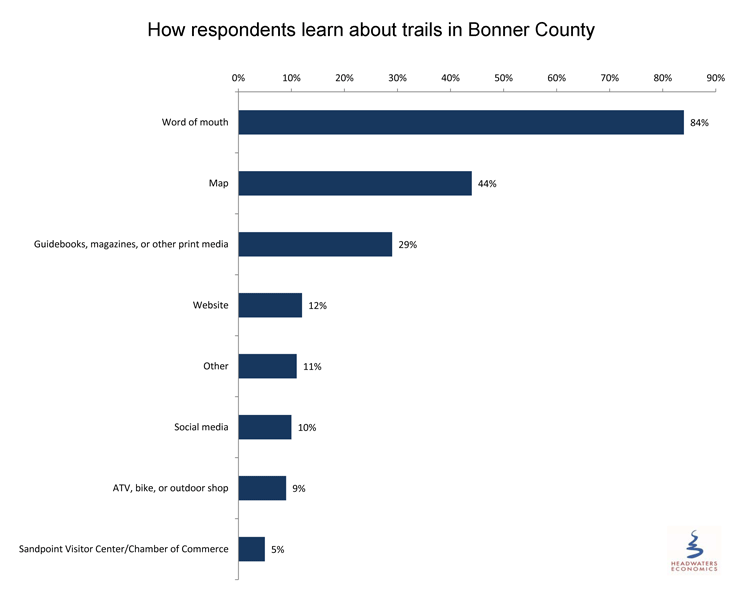
Potential for Trails as Transportation
Almost all current trail use is for recreation, not transportation. This is unsurprising given the largely rural population of the county. However, within towns there is a small group of users who walk, bike, bus, and carpool to work. For residents of towns across the county, 20 percent report using at least one of these forms of transportation each week, on average. This small group of users, along with demand from many residents for more trails and bike lanes near where they live, suggests there is an opportunity to increase the use of trails for transportation.
Funding Challenges
While residents want trail improvements, they generally do not want to pay for the improvements themselves. Nearly nine out of ten respondents support or strongly support funding improvements to trails via state or federal grants or private fundraising. Nearly half support or strongly support user fees, and roughly one in four support the use of sales or property tax. In short, those wishing to improve the trail system face substantial reluctance for local financial support. Success raising new funds may be more likely using a diverse mix of funding sources, and where local dollars can be significantly leveraged.
The Future
While current residents as a whole value area trails, survey results show that younger residents, newer residents, and business owners value them the most. This finding may be significant for Bonner County communities as they consider how to attract a younger population and entrepreneurs who will contribute to the long-term vitality of the region.
The LOR Foundation, whose goal is to enhance livability and quality of life in the Intermountain West through community-driven solutions, provided funding for this research to help communities better understand the use of trails and pathways, and to make informed choices about investing in and managing this infrastructure.
